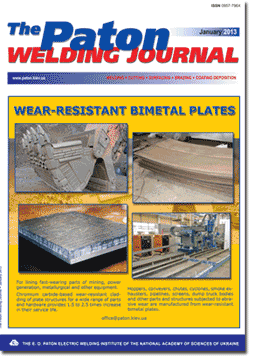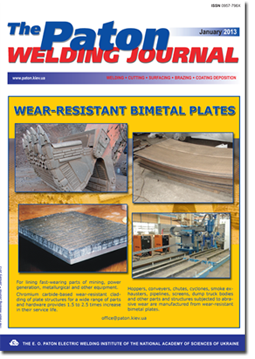| 2013 №01 (03) | 2013 №01 (05) |

The Paton Welding Journal, 2013, #1, 14-20 pages
ALGORITHM OF TECHNOLOGICAL ADAPTATION FOR AUTOMATED MULTIPASS MIG/MAG WELDING OF ITEMS WITH A VARIABLE WIDTH OF EDGE PREPARATION
T.G. SKUBA, V.V. DOLINENKO, V.A. KOLYADA and E.V. SHAPOVALOV
E.O. Paton Electric Welding Institute, NASU, Kiev, Ukraine
Abstract
Area of research is automation of the processes of multipass MIG/MAG welding of thick-walled items in the downhand position. Objective of research is producing a weld with specified width and reinforcement, not having any lacks-of-penetration or undercuts in the presence of external disturbing influences in the form of a change of geometrical parameters of butt edge preparation (cut-out area). Research task is development of technological adaptation algorithm, which ensures the specified height of welded layer. Research procedure is synthesis of mathematical model based on equations containing both phenomenological descriptions of the processes and regression dependencies. An algorithm is proposed for technological adaptation of butt edge preparation based on machine vision means for multipass MIG/MAG welding. The algorithm ensures calculation of automatic welding mode (voltage, current and speed of welding) in real-time, based on current geometrical parameters of edge preparation. The algorithm uses the developed mathematical of model «power source-arc of steady-state MIG/MAG welding process». In order to verify the algorithm, welding experiments were performed, in which a metal layer of constant thickness of 0.2cm with varying width of 2.0-3.3 cm was deposited on a steel plate. Range of variation of welding heat input is 4.0-8.5 J/cm with short-circuiting frequency of 5-54 Hz. No arc interruptions were observed, and defects of deposited layer macrostructure were absent. The proposed technological adaptation algorithm can be recommended for application in automatic control systems of multipass welding. 21 Ref., 8 Figures.
Keywords: multipass MIG/MAG welding, technological adaptation, layer of constant height, mathematical model, welding mode
Received: 26.07.12
Published: 28.01.12
References
1. Berezovsky, B.M. (2003) Mathematical models of arc welding. Vol. 2: Mathematical modeling and optimization of formation of different weld types. Chelyabinsk: YuUrGU.
2. Kiji, N., Kobayashi, K., Ishii, J. et al. (2003) Development of high efficiency arc welding methods. The Paton Welding J., 10/11, 56-60.
3. Poznyakov, V.D., Kiriakov, V.M., Gajvoronsky, O.A. et al. (2009) Investigation and development of the technology of arc welding of rail ends of frogs. In: Problems of resource and safe service of structures, constructions and machines. Kyiv: PWI, 579-584.
4. Tsaryuk, A.K., Ivanenko, V.D., Volkov, V.V. et al. (2009) Repair welding of turbine hull parts of heat-resistant steels without postweld heat treatment. Ibid., 519-524
5. Memhard, D., Pfeiffer, W., Siegele, D. (2005) Determination of residual stress in multipass weldments of high strength steels with experimental and numerical techniques. In: Proc. of Int. Conf. WELDS-2005 (Hamburg, Germany, 8-9 Sept. 2005), 1-14.
6. Gladkov, E.A. (2006) Control of processes and equipment in welding: Manual. Moscow: Akademia.
7. Srimath, N., Murugan, N. (2011) Prediction and optimization of weld bead geometry of plasma transferred arc hardfaced valve seat rings. Europ. J. Sci. Res., 51(2), 285-298.
8. Choteborsky, R., Navratilova, M., Hrabe, P. (2011) Effects of MIG process parameters on the geometry and dilution of the bead in the automatic surfacing. Res. Agr. Eng., 57(4), 56-62.
9. Muligan, S.J. (2007) Development of laser vision-based adaptive control of robotic multipass MAG welding: TWI Ind. Mem. Peport Summary 872. Cambridge: TWI.
10. Moon, H.S., Beattie, R.J. (2002) A fully automated adaptive pressure vessel welding system. In: Proc. of AWS Conf. (Orlando, Florida, 17-18 Sept. 2002), 1-6.
11. Moon, H.S., Beattie, R.J. (2002) Development of adaptive fill control for multitorch multipass submerged arc welding. Int. J. Adv. Manuf. Technol., 19(12), 867-872.
12. Lipnevicius, G. (2009) Robotic shop. Modern Steel Construction, May, 1-3.
13. Belchuk, G.A., Gatovsky, K.M., Kokh, B.A. (1980) Welding of ship structures: Manual. Leningrad: Sudostroenie.
14. Volchenko, V.N., Yampolsky, V.M., Vinokurov, V.A. et al. (1988) Theory of welding processes: Manual on equipment and technology of welding production. Ed. by V.V. Frolov. Moscow: Vysshaya Shkola.
15. (1991) Welding and materials being welded. Vol.1: Weldability of materials: Refer. Book. Ed. by E.L. Makarov. Moscow: Metallurgiya.
16. Rykalin, N.N. (1951) Calculations of thermal processes in welding. Moscow: Mashgiz.
17. Marishkin, A.K., Popkov, A.M., Postaushkin, V.F. (1970) Melting of electrode wire in automatic welding with systematic arc gap short-circuiting. Avtomatich. Svarka, 4, 9-11.
18. Nikolaev, G.A. (1978) Welding in machine-building. Vol. 1. Moscow: Mashinostroenie.
19. Potapievsky, A.G. (2007) Consumable-electrode gas-shielded welding. Pt 1: Welding in active gases. 2nd ed. Kiev: Ekotekhnologiya.
20. Gill, F.E., Murray, W., Wright, M.T. (1985) Practical optimization. Moscow: Mir.
21. Ochkov, V.F. (2009) Mathcad 14 for students and engineering. St.-Petersburg: BHV.
Suggested Citation
T.G. SKUBA, V.V. DOLINENKO, V.A. KOLYADA and E.V. SHAPOVALOV (2013) ALGORITHM OF TECHNOLOGICAL ADAPTATION FOR AUTOMATED MULTIPASS MIG/MAG WELDING OF ITEMS WITH A VARIABLE WIDTH OF EDGE PREPARATION. The Paton Welding J., 01, 14-20.The cost of subscription/purchase order journals or individual articles
| Journal/Currency | Annual Set | 1 issue printed |
1 issue |
one article |
| TPWJ/USD | 384 $ | 32 $ | 26 $ | 13 $ |
| TPWJ/EUR | 348 € | 29 € | 24 € | 12 € |
| TPWJ/UAH | 7200 UAH | 600 UAH | 600 UAH | 280 UAH |
| AS/UAH | 1800 UAH | 300 UAH | 300 UAH | 150 UAH |
| AS/USD | 192 $ | 32 $ | 26 $ | 13 $ |
| AS/EUR | 180 € | 30 € | 25 € | 12 € |
| SEM/UAH | 1200 UAH | 300 UAH | 300 UAH | 150 UAH |
| SEM/USD | 128 $ | 32 $ | 26 $ | 13 $ |
| SEM/EUR | 120 € | 30 € | 25 € | 12 € |
| TDNK/UAH | 1200 UAH | 300 UAH | 300 UAH | 150 UAH |
| TDNK/USD | 128 $ | 32 $ | 26 $ | 13 $ |
| TDNK/EUR | 120 € | 30 € | 25 € | 15 € |
AS = «Automatic Welding» - 6 issues per year;
TPWJ = «PATON WELDING JOURNAL» - 12 issues per year;
SEM = «Electrometallurgy Today» - 4 issues per year;
TDNK = «Technical Diagnostics and Non-Destructive Testing» - 4 issues per year.


